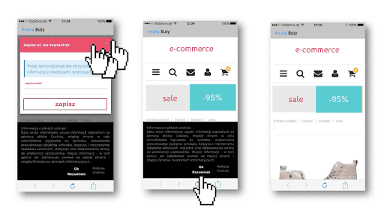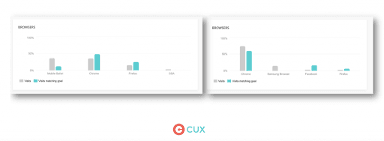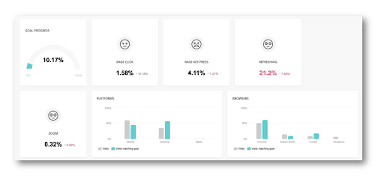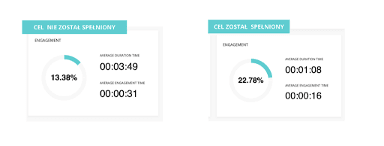October 21, 2025
6 min read
5 ways to optimize the customer journey (That will boost your conversion)
For e-commerce businesses, ensuring the comfort of customer experiences throughout the customer journey is a make-or-break situation.

Effective customer journey optimization is a continuous, data-driven process of identifying and eliminating user frustration at every critical touchpoint to make conversion paths more efficient.
Tools for qualitative behavior analysis are a must-have for e-commerce businesses aiming to thrive in a highly competitive market. Luckily, there are several universal ways to optimize user paths.
1. Shorten the path to purchase (especially from social media)
The customer journey, especially the one leading from social media to the store, should be as straightforward and intuitive as possible. Pay attention to the areas where customers need to fill in or check certain information. If an advertisement promises a discount code, provide the autofill option in the shopping cart. Remember that the consumer has already taken a certain path to reach your product. So, if you are promoting a specific item, set up the campaign to lead directly to the purchase with a single click. If you are promoting a group of products, filter them for the customer. The conversion will surely thank you!

2. Analyze traffic sources to understand intent
The source of traffic you want to analyze is incredibly important. A store that receives 90% of its traffic from marketplaces will build the customer journey differently compared to a store that relies solely on brand image campaigns. Make sure to use the grouping feature for visit recordings specific to a particular source. It's a goldmine of knowledge!
This allows you to understand if users from different campaigns (e.g., a b2b customer journey vs. a retail customer journey) behave differently and have different expectations.
3. Optimize for all browsers (especially mobile defaults)
In most cases, a significant portion of e-commerce traffic comes from mobile phones. Therefore, the content, especially advertisements, is displayed on default phone browsers like Mobile Safari (iOS) or Samsung Browser (Android). These browsers rarely convert. Why? Often, during the user journey design process, they are overlooked or not given enough attention. To determine whether default browsers can affect the quality of user experiences in your case, compare conversions on several different browsers. Detailed mobile app analytics can also reveal issues specific to a certain system or device.

Don't forget about frequent updates! Native browser creators often update or completely change their usage policies. This can have a direct impact on the quality of your website displays. These are also tools that often do not save cookies by default!
4. Actively eliminate user frustration at critical points
Minor frustrations usually do not impact the final purchasing decision of customers. However, the situation changes dramatically when these frustrations concern critical points of your sales funnel, such as registration or checkout.

One frustration that e-commerce stores often overlook is issues with checkboxes. It frequently happens that checkboxes required for form completion are too small, too close to the screen edges, not sensitive enough, or not marked with an appropriate color indicating their necessity. This leads to a multitude of negative emotions in users. Identifying these moments is a key part of eliminating user frustration.
5. Use behavioral analytics to find and fix conversion failures
Often, during customer journey analysis, it becomes evident that the path that does not lead to conversion is more significant than the path leading to a purchase.

To understand and diagnose the problems users face, you need a comparative analysis. By comparing behaviors of customers who achieved their goals versus those who did not, you can quickly identify "forks" or points where non-converting users deviate from the purchase path. Selecting recordings specific to the funnel and goal can help you with that.
How to analyze customer journey data
These five tips are a great start, but true optimization begins with data. Instead of guessing where the problems are, you can see them.
-
Use customer journey maps: Instead of looking at individual sessions, start by analyzing aggregated paths. This will show you where users are dropping off in large numbers.
-
Segment behaviors: Use behavioral segmentation to separate users who show signs of frustration (e.g., rage clicks, chaotic movement) from those who move smoothly through the process.
-
Analyze examples: Once you've identified a problematic step, watch visit recordings just for that segment. You'll see the exact customer journey map example that leads to failure.
Your next steps in optimization
Optimizing the customer journey isn't a one-time task; it's a continuous process. Start by implementing these five steps, but most importantly, start measuring their impact. Use the right tools to move from general observations to specific, data-driven actions that will actually improve your bottom line.
Frequently Asked Questions (FAQ)
Q: What is customer journey optimization?
A: Customer journey optimization is the process of analyzing and improving all customer touchpoints with your brand, from the first interaction to purchase and retention. The goal is to remove friction and user frustration to make the process as smooth and intuitive as possible.
Q: What's the difference between a B2B and B2C (retail) customer journey?
A: A b2b customer journey is typically longer, involves multiple decision-makers, and is based on building trust and logic. A retail customer journey is often shorter, more impulsive, and heavily driven by emotion and price.
Q: What is the best tool to analyze a conversion path?
A: The best tools are platforms that combine quantitative data (hard numbers) with qualitative data (session recordings, heatmaps). CUX allows you to not only see where users drop off the path but why they do it by showing you their actual behavior.
